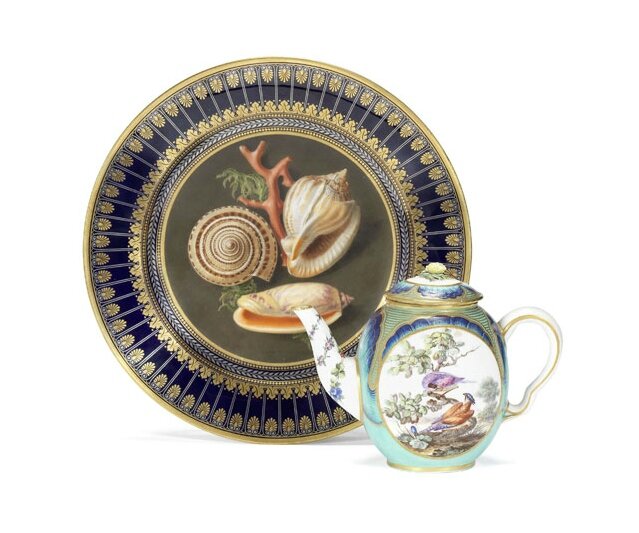Bonhams to sell Madame de Pompadour's favourite porcelain which surfaced in Devon after 350 years
Madame De Pompadour (1721- 1764), the mistress of Louis XV loved Sèvres porcelain. Photo: Bonhams.
LONDON.- Two wonderful ceramic survivors – a Sèvres plate and teapot - have just been discovered in Devon by one of Bonhams local specialists, Sam Tuke, of the Exeter office. They will form part the next European Ceramics sale at Bonhams 101 New Bond St saleroom in London on 18th June
Sam says: “I was doing a house call just before Christmas as the client was moving home and wanted a collection of Chinese blue and white porcelain valued. I ended up doing a total contents valuation and as I was working my way through the house spotted something that looked interesting on the pine dresser in the kitchen.”
“It turned out that I’d found a rather special Sèvres tea pot with a very unusual colour. On looking around some more I also found a Sèvres plate that was shown at the Great Exhibition in 1851. The client had inherited the teapot and plate but had no idea that either of them might be valuable. She just thought them rather pretty, which they certainly are.”
Most of these discovered pieces turn out to late 19th century copies with a market value of around £500. But this teapot is a very unusual colour and although the maker’s mark is rather smudged it has been confirmed as a piece of Sevres from around 1765, the high Rococo period.
The teapot and plate were brought to London and examined by Bonhams Head of European Ceramics, Sebastian Kuhn, who confirmed that both items were indeed rare Sèvres pieces. With only one other known saucer and milk jug in this style known to have survived – they sold for $25,000 in New York – these two Devon discoveries could make between £8,000 to £10,000.
Sam Tuke adds: “If you are not absolutely sure of what you have, do dust carefully! Or have Bonhams pop in to give you a free valuation.”
Madame De Pompadour (1721- 1764), the mistress of Louis XV loved Sèvres porcelain. This passion of hers is well documented. She was responsible for the development of the manufactory of Sèvres, which became one of the most famous porcelain manufacturers in Europe and which provided skilled jobs for the region. She was a major patron of architecture and the decorative arts like porcelain.
This is just the latest discovery by Sam Tuke in Devon. Last year he virtually stumbled across a carved Indian temple step in the garden of a client’s bungalow where it was being used as a front doorstep. It sold in London for £553,250 some weeks later to the astonishment of its owners.
There was a battle between buyers in the room and on the telephone for this remarkable find, a rare Buddhist Indian carved stone temple step, which finally sold for over half a million pounds against a pre-sale estimate of £20,000 to £30,000. There were no fewer than eight telephone bidders and three in the saleroom.
The carved granite temple step (Sandakada pahana) is similar to those found in the ancient city of Anuradhapura in Sri Lanka. The beautiful 1,000 year old pre-Hindu stone step is one of only six examples known to date from this period, making this discovery the seventh. The temple step is a feature unique to Sinhalese architecture in Sri Lanka. The massively heavy – three-quarters of a ton stone measure eight ft by four foot and is six inches thick.
The Devon based owners, Mike and Bronwyn Hickmott, commented after the sale: “We are overwhelmed with the price achieved. It goes beyond all our expectations.” Mrs Hickmott added: “I’d like to say a special thank you to Sam Tuke of Bonhams Exeter office. We had been turned away by other international auction houses as well as television antiques shows. Everyone pooh-poohed our belief that the stone was special. It was only Sam’s determination to research the stone that has led to this happy result. We are thrilled.”

/https%3A%2F%2Fprofilepics.canalblog.com%2Fprofilepics%2F1%2F0%2F100183.jpg)
/https%3A%2F%2Fstorage.canalblog.com%2F03%2F02%2F119589%2F96711876_o.jpg)
/https%3A%2F%2Fstorage.canalblog.com%2F11%2F31%2F119589%2F94773502_o.jpg)
/https%3A%2F%2Fstorage.canalblog.com%2F20%2F83%2F119589%2F94772815_o.jpg)
/https%3A%2F%2Fstorage.canalblog.com%2F26%2F72%2F119589%2F75604929_o.jpg)
/https%3A%2F%2Fstorage.canalblog.com%2F59%2F60%2F119589%2F26458628_o.jpg)



/http%3A%2F%2Fstorage.canalblog.com%2F33%2F98%2F119589%2F110283321_o.jpg)
/http%3A%2F%2Fstorage.canalblog.com%2F80%2F00%2F119589%2F71822804_o.png)
/http%3A%2F%2Fstorage.canalblog.com%2F72%2F20%2F119589%2F32466285_o.jpg)
/image%2F1371349%2F20240425%2Fob_c453b7_439605604-1657274835042529-47869416345.jpg)